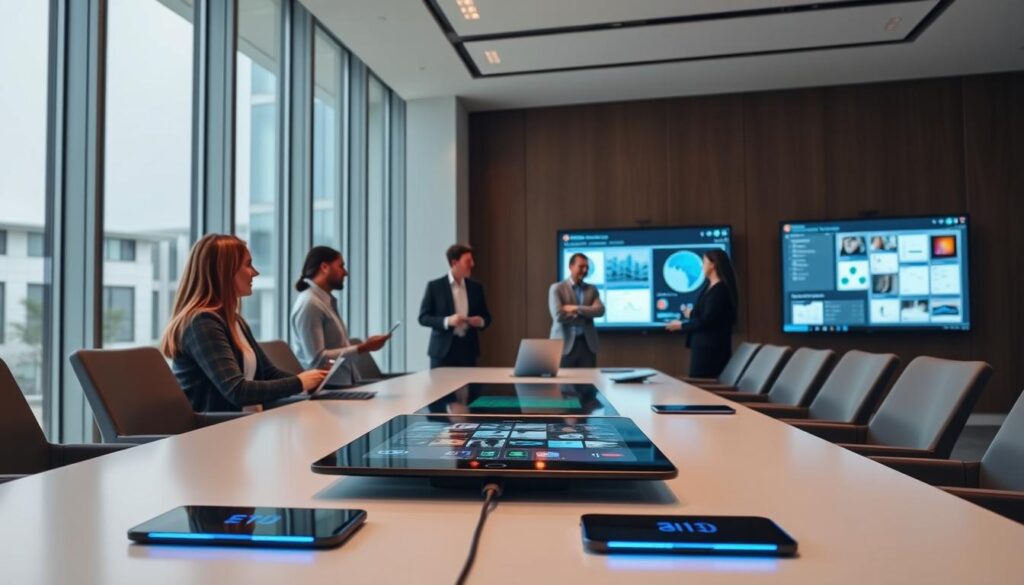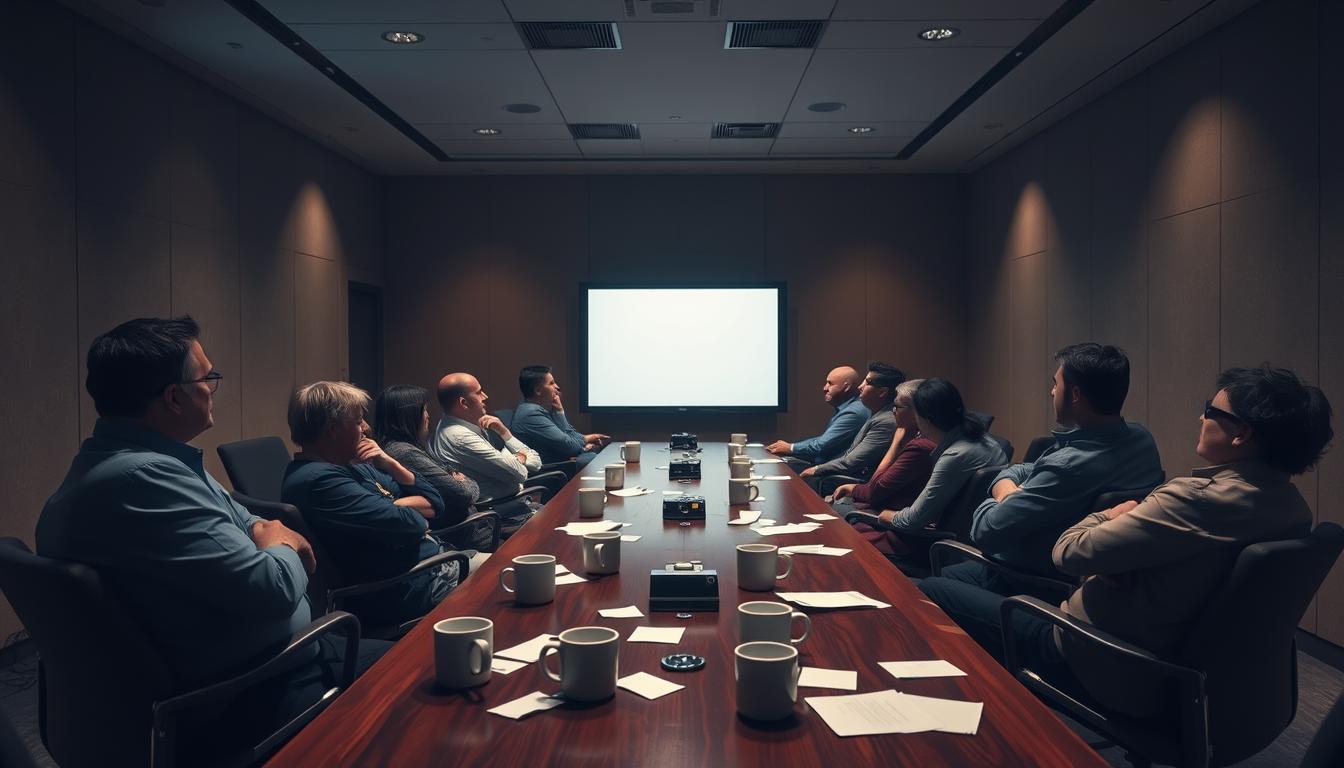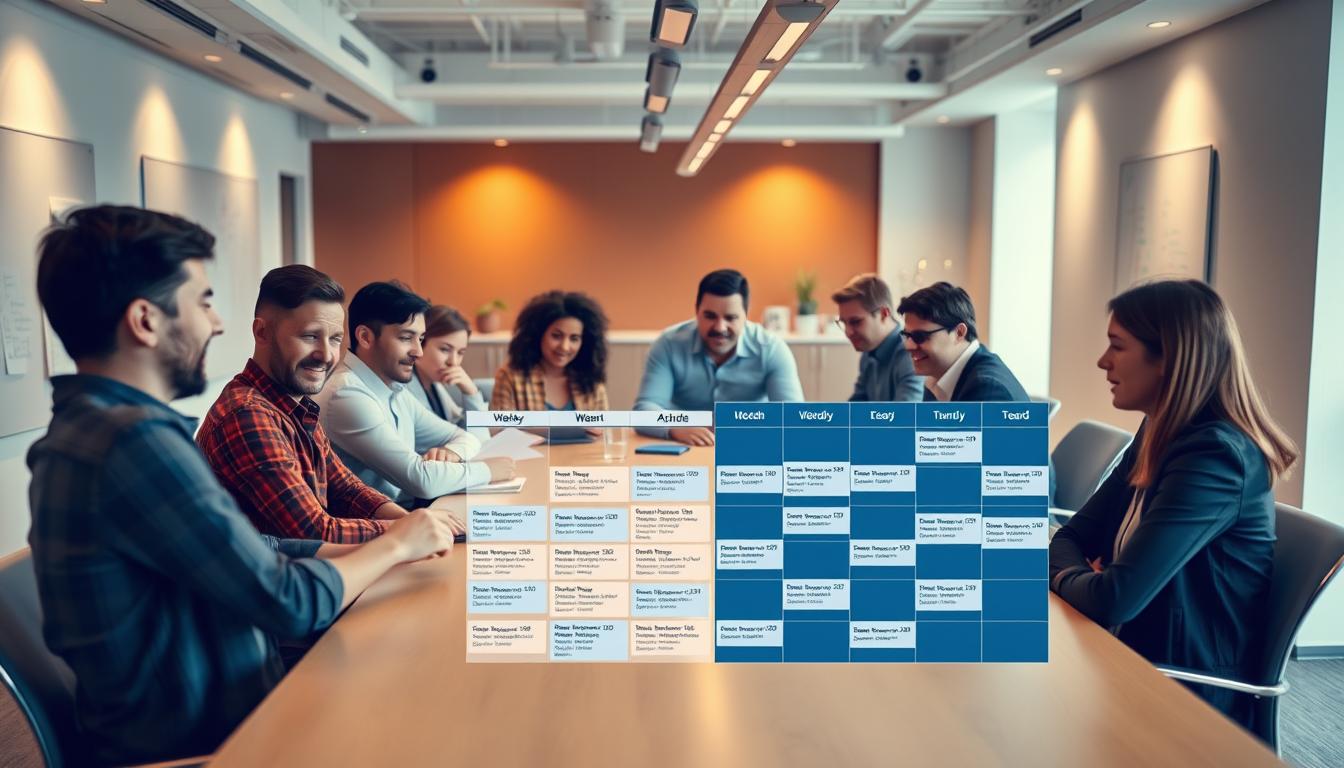In today’s fast-paced business world, running efficient meetings is key for improving productivity. Good meeting management streamlines workflow and helps reach goals. With more people working remotely, knowing how to conduct quick, effective meetings is vital. Focusing on clear communication and goals boosts meeting productivity and fosters a successful environment.
Introduction to Time-Efficient Meetings
Time-efficient meetings are key for better team productivity. They ensure discussions stay focused and goals clear. This focus on efficiency helps accomplish specific objectives.
A good meeting avoids confusion and doesn’t waste time on unimportant things. When everyone knows the goal, participation improves. This method saves time and increases productivity, making every discussion moment valuable.
Understanding the Importance of Meeting Management
Turning team gatherings into a source of productivity and innovation is what effective meeting management is all about. To make meetings productive, knowing the essentials is crucial for any group looking to improve. Setting clear goals, planning the agenda well, and promoting everyone’s input are the main ingredients for success. Also, steering clear of common meeting mistakes enhances teamwork and keeps the atmosphere positive.
What Constitutes a Productive Meeting?
Productive meetings stand out due to certain traits.
- Defined goals that clarify the meeting’s intent.
- A structured agenda outlining discussion topics.
- Everyone’s active involvement to introduce different ideas.
- Clear next steps that everyone understands after the meeting.
- A positive vibe that boosts morale and participation.
Identifying Common Pitfalls in Meetings
Yet, some meetings don’t go as planned due to familiar setbacks.
- Ambiguous aims that confuse the meeting’s objective.
- Low participation, leading to inefficiency and lost resources.
- No follow-up on tasks, affecting responsibility.
- Too much unrelated chat, distracting from the main agenda.
Strategies to Run Time-Efficient Meetings
Effective meeting strategies can make your gatherings more efficient. By setting clear goals and using the right tools, teams can avoid the traps of bad meetings. This leads to focused talks and better results.
Establish Clear Objectives and Agendas
Clear objectives are key for successful meetings. Knowing the purpose and what’s expected helps everyone contribute better. An agenda lays out topics and keeps the meeting on track. It also stops any off-topic talks.
Utilize Meeting Management Software for Efficiency
Using meeting management software, like Ninety, can change how meetings are done. These tools make everything easier, from setting them up to joining in. They improve teamwork with features for different roles, keeping everyone involved and productive.
Enhanced Communication Techniques for Meetings
Good communication is key for meetings to succeed. It lets ideas flow and makes everyone feel important. Including everyone in the team helps bring different views into decisions. Using clear communication methods and visual aids can make discussions more engaging.
Encouraging Participation from All Team Members
It’s important to make a space where everyone wants to take part. To get more involvement, try these:
- Asking open-ended questions to spark conversation.
- Using a round-robin approach to ensure everyone gets to speak.
- Celebrating everyone’s input to encourage them to keep contributing.
This way, meetings become livelier and more meaningful.
Utilizing Visual Aids and Collaborative Tools
Adding visual aids can really help people understand and remember the discussion. Using things like slides, charts, and infographics makes complex ideas easier to grasp. Tools that let people work together, like shared documents and digital whiteboards, allow for instant feedback from the team. This makes communication smoother and keeps everyone involved during the meeting.
Run Time-Efficient Meetings with Role-Specific Approaches
Using role-specific methods in meetings lets teams plan according to their various jobs. This special way makes it easy for leaders to steer talks. At the same time, everyone can share important views linked to their work. By assigning clear roles for meetings, everyone knows what they need to do. This helps them take responsibility.
Meetings become more beneficial when they cover all essential parts of a project well.
Role-specific meeting strategies bring many good things:
- Improved focus on agenda items by aligning discussions with the specific expertise of participants.
- Greater engagement from team members as they feel their input is valuable and relevant.
- Streamlined decision-making processes due to clearly defined meeting roles that prevent confusion and overlap.
Leveraging Technology to Streamline Meetings
Meeting technology is key to making meetings more productive. It simplifies how we manage them. Using meeting management software makes organizing meetings easy. This lets everyone focus more on the conversation.
These tools improve meetings by handling scheduling, sending reminders, and making it easier to work together. So, meetings become more effective.
Popular Meeting Management Software to Consider
There are many software options to help manage your meetings better:
- Microsoft Teams
- Zoom
- Slack
- Asana
- Trello
These apps offer video calls, messaging, and connections to other important tools. They have different features, so you can choose what works best for your team.
Integrating Calendar Sync and Email Reminders
Linking your calendar with meeting software avoids scheduling issues. It makes sure everyone knows when meetings are. Sending automatic email reminders helps improve attendance.
This helps everyone get ready in time. Many tools work well with calendars like Google Calendar and Outlook. This makes planning meetings even smoother.

Best Practices for Conducting Virtual Meetings
As more of us work from home, it’s vital to nail down virtual meeting best practices. Making your meeting space better can lead to more productivity. It also helps keep everyone involved. Ensure your setup has little to no distractions and promotes everyone to take part.
Optimizing Your Virtual Meeting Environment
Having a steady internet and a quiet place makes virtual meetings better. For the ideal setting, do the following:
- Choose a well-lit space that allows for clear visibility.
- Minimize background distractions, including noise and visual clutter.
- Test audio and video equipment beforehand to avoid technical issues.
Maintaining Engagement in Remote Settings
Keeping team members engaged during remote meetings is key. Adding interactive features can keep interest high. Try these strategies:
- Incorporate polls and surveys to gather instant feedback.
- Use breakout rooms for smaller group discussions.
- Encourage participation through icebreakers or fun activities.
Creating an Inclusive Meeting Culture
Creating a culture where everyone feels included is key for effective team work. It lets us hear many different ideas, and everyone gets a chance to participate equally. This way, teams can come up with more creative solutions and succeed together.
Making Sure Everyone’s Voice is Heard
We can make sure everyone gets to speak up by using certain strategies. This includes:
- Using round-robin sharing so everyone has a turn to talk.
- Encouraging those who are usually quiet to share their thoughts.
- Creating a space where everyone can give feedback without worrying about being judged.
Diversity and Its Impact on Meeting Outcomes
Diversity makes our meetings better and our decisions stronger. When people from different backgrounds work together, teams can:
- Spot issues that might be missed by a similar group of people.
- Come up with more ideas, which leads to better solutions.
- Enhance how they work together, building respect and understanding.
Time Management Techniques During Meetings
Using good time management skills in meetings can boost how much you get done. Putting strict time caps on each topic keeps talks on track. Teams do better when they have a clear plan. It shows exactly what will be talked about and when.
A timekeeper can make meetings run smoother by keeping track of time. They remind people to stick to their moment. This stops one issue from taking over the whole meeting.
Taking short breaks keeps everyone focused. Breaks let people rest and jot down thoughts. This makes the conversation better.
Using these strategies creates an organized meeting atmosphere. Every important point gets covered, considering everyone’s time. This leads to shorter, more useful meetings.
Reflection and Review: The Key to Continuous Improvement
Looking back after meetings is key to making the next ones better. When we ask people what they think, we learn and get better. We find what works and what needs to change. It’s important for everyone to feel they can speak their mind.
Soliciting Feedback from Participants
Getting feedback the right way helps us keep getting better. We can do this through:
- Anonymous surveys to encourage honest responses.
- Open discussions at the end of meetings to collect immediate impressions.
- Follow-up emails requesting specific thoughts on what worked well and what could be improved.
This feedback helps us know what to do next. It also shows we’re serious about making meetings better. What we learn from everyone helps make our meetings more productive and interesting.
Conclusion
Throughout this article, we learned that having quick meetings is key for better work and keeping everyone on the same page. By using smart strategies, like setting clear goals and using the right tech, companies can make their meetings more effective. This helps everyone speak up and share ideas.
Also, listening to feedback helps teams improve and achieve goals together. This not only makes the best use of resources but also keeps employees more involved. In short, quick meetings can change how well discussions go and how successful projects are in any company.
In today’s fast-moving business world, it’s crucial for teams to follow these tips carefully. By focusing on making meetings shorter and to the point, companies can see real progress and new ideas. This leads to better results in business.



